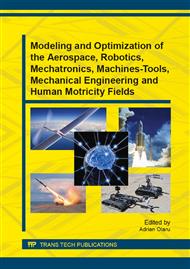[1]
R. E Kalman, A new approach to linear filtering and prediction problems, Trans. ASME, Ser. D, J. Basic Eng., vol. 82, March 1960, pp.35-45.
Google Scholar
[2]
A M.G. Leonard, F.S. Stanley, Discovery of the Kalman Filter as a practical tool for aerospace and industry, NASA Technical Memorandum 86847, (1985).
Google Scholar
[3]
R.G. Brown, Introduction to random signal analysis and Kalman filtering, ISBN 0471-08732-7, John Wiley and Sons Inc , (1983).
Google Scholar
[4]
M. Ghanail and K. Chafaa, Kalman Filter in Control and Modeling in Kalman Filter: Recent Advances and Applications, In-Tech, Croatia, 2009, pp.71-86.
DOI: 10.5772/6801
Google Scholar
[5]
P. Bucur, Topics in Mechanics of Embarked Systems, Augusta Publishing House, Timişoara, 2001, pp.210-326.
Google Scholar
[6]
P. Bucur, Fuse theory and design, MTA Publishing, Bucureşti, 1997, pp.166-173.
Google Scholar
[7]
E. Carafoli, V.N. Constantinescu, Dynamics of compressible fluids, Academiei Publishing, Bucureşti, 1984, pp.403-446.
Google Scholar
[8]
M. Niţă, F. Moraru, N. Patraulea, Airplanes and rockets. Design concepts, Militară Publishing, Bucureşti, 1985, pp.203-291.
Google Scholar
[9]
J. Richard, J. Meinhold, D. Nozer, R. Singpurwalla, Understanding the Kalman filter, The American Statistician, Vol. 37, No. 2, 1983, pp.123-127.
DOI: 10.1080/00031305.1983.10482723
Google Scholar
[10]
M.I. Ribeiro, Kalman and Extended Kalman Filters: Concept, Derivation and Properties, Institute for Systems and Robotics, Lisabona, (2004).
Google Scholar
[11]
G. Welch, G. Bishop, An introduction to the Kalman filter, University of North Carolina at Chapel Hill, 2006, pp.1-16.
Google Scholar
[12]
K. Rachel, Kalman filtering. Implementation with MATLAB, Helsinki, (2004).
Google Scholar
[13]
M. Ghinea,V. Fireteanu, MATLAB. Numerical calculus. Graphique. Applications, Publishing TEORA, Bucuresti, (2008).
Google Scholar
[14]
L.A. Zadeh, E. Polak, Systems theory, Tehnică Publishing, Bucureşti, 1970, pp.317-328.
Google Scholar
[15]
R.A. Satya , Sensitivity of optimal control systems, McMaster University, Open Access Dissertations and Theses. Paper 8543, 1966, pp.23-105.
Google Scholar
[16]
K.J. Astrom, Control System Design, University of California, 2002, pp.177-215.
Google Scholar
[17]
V. Sonti, Phase margins, designing with Bode plots, compensators, Indian Institute of Science, 2008, pp.1-10.
Google Scholar
[18]
B. Zabalza,T. Anino, Improved Kalman filter based inverter control for reduction of low order current harmonics due to isolation transformers in renewable energy sources, Universitat Jaume I de Castello, ICREPQ 09, Valencia, 2009, pp.1-6.
DOI: 10.24084/repqj07.317
Google Scholar
[19]
J. L Corona, Application of Kalman filter and PIC control for direct inverted pendulum control, Faculty of California State University, Chico, 2009, pp.29-51.
Google Scholar
[20]
F. Auger et Al., Industrial applications of the Kalman filter: A review, Research database of Aalborg University, 2012, pp.1-16.
Google Scholar
[21]
Information on www. cs. ucl. ac. uk/staff/T. Fletcher.
Google Scholar


